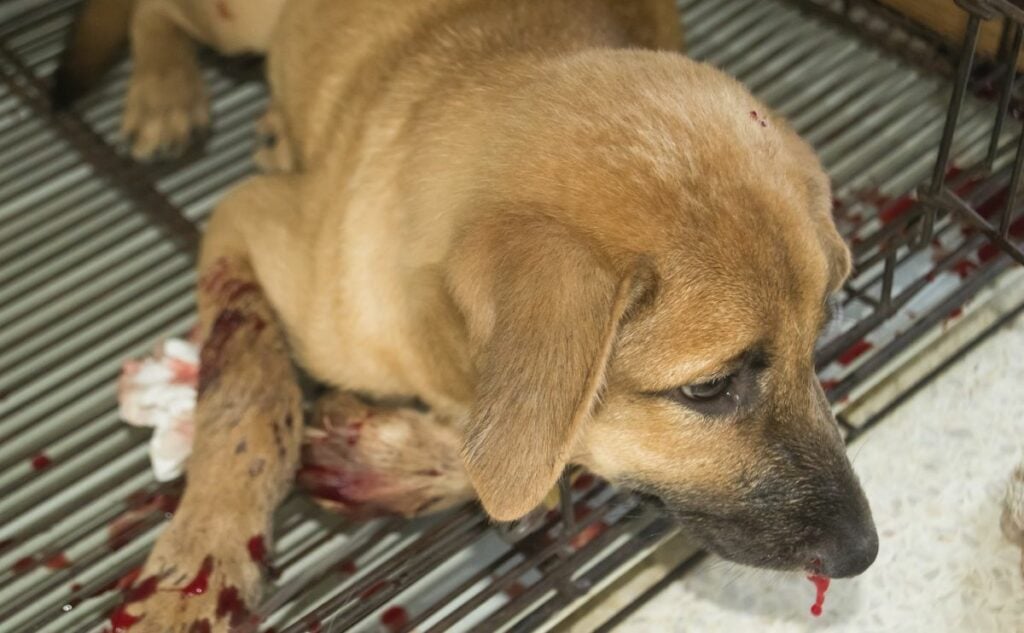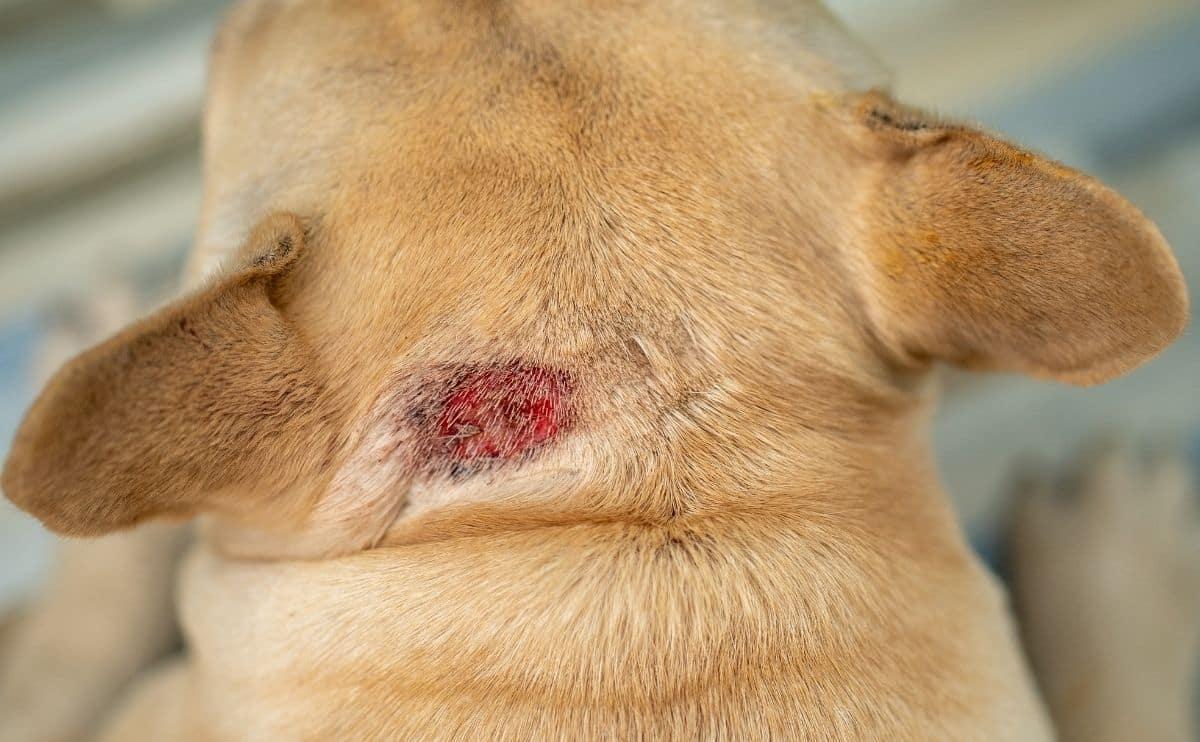Von Willebrand’s Disease In Dogs: At-Risk Breeds, Testing, Symptoms & More
When you purchase through links on our site, we may earn a commission. Here’s how it works.

Von Willebrand’s Disease is an inherited bleeding disorder that can prevent normal blood clotting and lead to severe bleeding. It’s been documented in over 50 dog breeds, and some breeds are at a high risk of developing von Willebrand’s Disease. This bleeding disorder in dogs can range from mild to life-threatening, so it’s important to know if your dog has this disease.
Table of Contents
What Is Von Willebrand’s Disease In Dogs?
Von Willebrand’s disease (vWD) is the most common inherited bleeding disorder in dogs (and humans). In vWD, the body doesn’t produce enough proteins, called von Willebrand factor (vWF), which are instrumental in helping platelets stick together and form a blood clot. This clotting disorder results in excessive bleeding, which could be life-threatening without medical intervention for some dogs.
The disease has three forms (Types 1, 2, and 3). Type 1 von Willebrand’s disease is typically less severe than Types 2 and 3; however, it can still cause serious bleeding problems. Both male and female dogs can develop the disease or be carriers of the genetic mutation.
Von Willebrand’s disease is inherited in an autosomal recessive pattern. This means that a dog must inherit two copies of the abnormal gene (one from its mother and one from its father) before health is affected. A dog that inherits only one copy of the abnormal gene will have no signs of the disease but will be a carrier and may pass the gene on to any offspring.
Which Breeds Are Predisposed To VWD?
Nearly 50 different breeds have presented with von Willebrand’s disease. The most commonly affected breeds are the Doberman Pinscher, German Wirehaired Pointer, German Shorthaired Pointer, German Shepherd, Scottish Terrier, and Shetland Sheepdog.
The faulty gene has been found in up to 70% of Doberman Pinschers. Fortunately, this doesn’t mean that all will develop the disease, but they may be a carrier of the disease. And the mildest form of the disease is most common in Dobermans. Also noteworthy, up to 30% of Scottish Terriers and Shetland Sheepdogs can carry the faulty gene.
Below are some of the most common breeds prone to vWD and the types they can inherit.
Type 1 (Least Severe)

In Type 1 von Willebrand’s disease, all the necessary proteins that form von Willebrand factor are present but at low levels. This type usually causes mild bleeding, although some dogs may exhibit more severe signs. Some common breeds most affected include:
- Bernese Mountain Dogs
- Dachshunds
- Doberman Pinschers
- German Shepherds
- Golden Retrievers
- Greyhounds
- Shetland Sheepdogs
- Standard Poodles
Type 2 (Severe)

In Type 2, not all of the proteins that form von Willebrand factor are present, causing moderate to severe bleeding tendencies.
Type 2 vWD is usually seen in:
- German Shorthaired Pointers
- German Wirehaired Pointers
Type 3 (Most Severe)

Type 3 is the most severe form of vWD because the von Willebrand factor is completely absent or only has trace amounts of vWF protein. It most commonly affects:
- Chesapeake Bay Retrievers
- Scottish Terriers
- Shetland Sheepdogs
DNA Testing For Von Willebrand’s Disease In Dogs
If you’re concerned that your dog may have vWD, genetic testing (or DNA testing) can identify whether a dog is clear, a carrier of the genetic mutation, or is affected. You can ask your veterinarian’s office whether they do this type of genetic testing. Some laboratories offer at-home DNA test kits that are quick and easy to perform on saliva or hair samples. We recommend several at-home DNA test kits that can identify all three types of vWD: EasyDNA, Embark, and Wisdom Panel. See our reviews of the best dog DNA tests to see how these companies compare and what else you can learn about your dog through a DNA test.
Von Willebrand’s Disease Symptoms
Many dogs with Type 1 vWD never show signs or have very mild bleeding tendencies. Prolonged bleeding after trauma or surgery may be the first time an abnormality is noticed. More severe signs and symptoms of von Willebrand’s disease in dogs include:
- Spontaneous bleeding from the nose or gums
- Bloody urine or stool
- Vaginal bleeding
- Bruising or bleeding after spaying or neutering
- Prolonged bleeding after an injury or surgery
- Excessive bleeding during surgery
What Are Other Risks Associated With VWD?
In addition to excessive bleeding after an injury or surgery, other conditions, such as certain infections or endocrine disorders, can exacerbate bleeding in dogs with vWD. Also, certain medications may decrease platelet function and could increase the risk of spontaneous bleeding in dogs with vWD. These include:
- Ampicillin/Amoxicillin
- Antihistamines
- Antacid medications
- Estrogens
- Heparin
- NSAIDs (non-steroidal anti-inflammatory drugs), e.g., meloxicam, carprofen
- Penicillin
- Sulfa-based antibiotics
- Theophylline
Diagnosis
In many cases, von Willebrand’s disease in dogs isn’t diagnosed until pre-surgery evaluations by a veterinarian. If your vet thinks your dog may be at risk of having vWD, they may take a blood sample to measure the concentration of von Willebrand factor.
Another screening test commonly performed just before surgery is the buccal mucosal bleeding time (BMBT) test, which measures a dog’s ability to form a small clot. Once the dog is under anesthesia, the surgeon makes a small incision inside the lip and measures the time it takes for the blood to clot. If the blood takes too long to clot, vWD is suspected.
Treatment
Unfortunately, there are no medications or alternative therapies that can permanently boost a dog’s production of von Willebrand factor. If your dog has vWD, bleeding from minor wounds can be controlled using bandages, wound glue, or sutures. Treatment of a severe bleeding incident usually requires a blood or plasma transfusion to stabilize the dog.
vWD-affected dogs undergoing surgery are typically treated with a transfusion of blood or plasma to increase the amount of von Willebrand factor in their system. The surgeon may also administer a synthetic hormone called desmopressin acetate (DDAVP) to temporarily increase the level of von Willebrand factor. However, DDAVP only works for dogs with Type 1 vWD, and it’s not effective for all dogs with Type 1.
Breeding Concerns
Dogs with von Willebrand’s disease or carriers of the genetic mutation should not be bred. The most reputable dog breeders will screen their dogs for vWD before breeding to ensure the disease doesn’t pass on to offspring. If you’re considering getting a purebred dog, especially one of the at-risk breeds, make sure you discuss the breeder’s genetic screening practices for vWD and any other breed-specific hereditary conditions.



